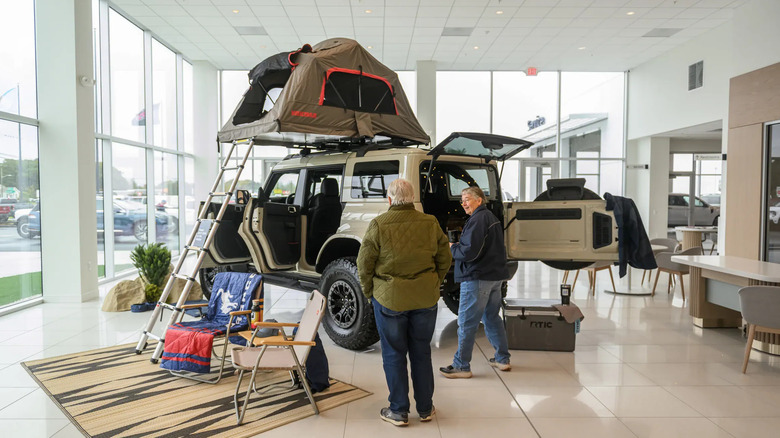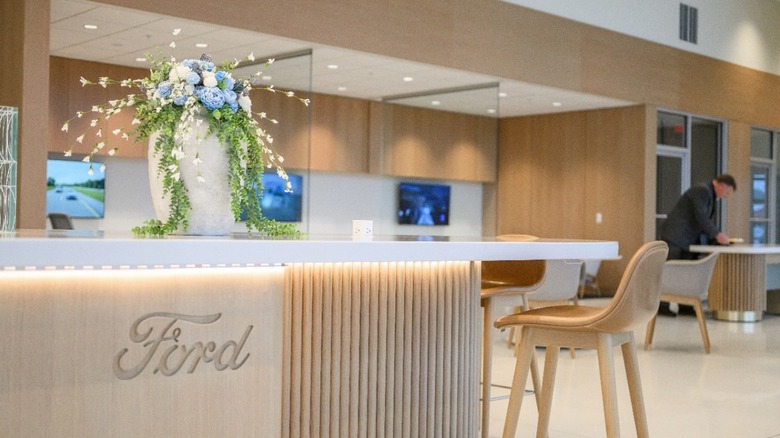Ford Is Making Major Changes To Its Dealerships, And Every Automaker Would Be Wise To Follow Suit
Think about the last time you purchased a car from a dealership. Finished? Now, think about the first time you did so, or even the first time you were with someone — perhaps a parent — who was buying from a dealership. The chances are, apart from the drinks offered and cars test-drove, the experience was pretty much identical.
There is a reason for this, as dealerships and salespeople generally follow the same process. As someone who's sold cars in a multitude of different dealerships, I'm fairly familiar with said process. Naturally, then, the environment in which salespeople want to sell their cars is fairly uniform too. There needs to be plenty of space in which to house the cars, and in the available space left, dealers can squeeze in desks, phones, and small displays to upsell promotional materials, paint protection packages, and whatever else they can think of.
However, the tides are changing. First, Subaru announced the implementation of its swanky new 'Subaru Connection Hubs,' and now Ford is planning to do much the same, too. The plan for the Blue Oval brand is to introduce an approach called 'Ford Signature 2.0,' which promises to put hospitality first. Say goodbye to salespeople and say hello to brand ambassadors. Sit down in a cozy and dedicated food and beverage area, and enjoy a variety of different environments in which you can choose to conduct your business.
Here's why Ford is shifting the way it sells cars
This might sound like a bold and proactive plan to shift the way in which Ford sells its cars, but in actuality, this is a reactionary move. See, it's the consumers who have changed; we aren't going in person to buy cars anymore, and now prefer buying cars from the comfort of our own homes. Now, dealerships are having to adapt to maximize their approach.
Firstly, salespeople no longer control the sale. You don't want that extended warranty or fancy metallic paint color? No problem, and no counteracting sales pitch, just don't select it. See, with us at home and them at the dealership, there is less influence over what and how much we spend.
Secondly, automakers own dealerships, and if we're all sitting at home instead of visiting them, then justifying such ownership becomes tricky. By adopting a more customer-centric approach, plus offering coffee lounges and play areas for kids and pets, dealers are making it more enticing for the purchase to happen in-store. Ford knows that flexibility is key, which is why they will give the option for customers to complete some or all of their purchases either in-store or at home. By the end of 2026, Ford plans to have 110 stores adopting this new purchase, positioned all over the globe.
Other automakers need to follow suit
Now, if other automakers want to leave their dealerships operating in the way that has been the norm for decades, that's fine, so long as they aren't anticipating any physical customers. Customers are switching to buying online out of convenience, but that doesn't mean we don't want to shop in person.
It's more a case of, if we can avoid a pushy sales pitch in a monochromatic showroom, then yeah, we will. However, if there's a place we can grab some lunch, perhaps check out a cool display of the model we're interested in clad in a myriad of off-roading options, and maybe even buy a t-shirt with the new car on, then great, that sounds like fun. It sounds more like an experience, and that's what dealerships need to focus on selling these days. Consumers just cannot get that kind of customer-focused experience when spending $50,000 on a new and spacious SUV from an iPad at home.
It's also somewhere enjoyable for customers to spend a few hours when they are having their car serviced in the years that follow that initial purchase. And, if a positive and customer-centric experience can be delivered time and time again, then we'll probably return in person when it comes time to replace that car. So, I say bravo to Ford and Subaru for trying out a bold new direction; it might just be what the automotive market needs in order to keep physical dealerships not just alive but also justified and desired.


